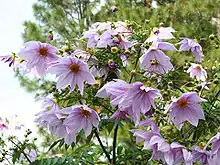Dahlia imperialis
Dahlia imperialis, or bell tree dahlia, is a flowering plant in the family Asteraceae that grows 8–10 metres tall. It is native to Mexico, Central America and Colombia. It is a plant of the uplands and mountains, occurring at elevations of 1,500–1,700 metres (4,900–5,600 ft), and its leaves are used as a dietary supplement by the Q'eqchi' people of San Pedro Carchá in Alta Verapaz, Guatemala.[1]
| Dahlia imperialis | |
|---|---|
 | |
| Scientific classification | |
| Kingdom: | Plantae |
| Clade: | Tracheophytes |
| Clade: | Angiosperms |
| Clade: | Eudicots |
| Clade: | Asterids |
| Order: | Asterales |
| Family: | Asteraceae |
| Genus: | Dahlia |
| Species: | D. imperialis |
| Binomial name | |
| Dahlia imperialis | |
It is a tuberous, herbaceous perennial, rapidly growing from the base after a dormant winter period, developing brittle, cane-like, 4-angled stems with swollen nodes and large tripinnate leaves, those near the ground soon being shed. The pendant or nodding flowerheads are 75-150mm across with ray florets lavender or mauvish-pink in colour.[2][3]
This species is fast-growing, the growth spurt being linked to shorter daylight hours, and usually comes into flower in autumn before the first frost. Propagation is by seed or by stem cuttings of some 30 cm (12 in) long having at least two nodes, laid horizontally below the soil.[4]
Some Dahlia species were brought from Mexico to Europe in the 16th century. D. imperialis was first described in 1863 by Benedikt Roezl (1823–1885), the great Czech orchid collector and traveller, who, ten years later in 1872–73, went on his odyssey through the Americas.[5]
References
- S. Booth, T. Johns & C. Y. Lopez-Palacios (1993). "Factors influencing the dietary intake of indigenous leafy greens by the K'ekchi people of Alta Verapaz, Guatemala". Ecology of Food and Nutrition. 31 (1 & 2): 127–145. doi:10.1080/03670244.1993.9991354.
- Dayle E. Saar, Neil O. Polans & Paul D. Sørensen (2003). "A phylogenetic analysis of the genus Dahlia (Asteraceae) based on internal and external transcribed spacer regions of nuclear ribosomal DNA". Systematic Botany. 28 (3): 627–639. doi:10.1043/01-78.1 (inactive 2021-01-10). JSTOR 25063902.CS1 maint: DOI inactive as of January 2021 (link)
- Booth, Sarah; Bressani, Ricardo; Johns, Timothy (1992). "Nutrient content of selected indigenous leafy vegetables consumed by the Kekchi people of Alta Verapaz, Guatemala". Journal of Food Composition and Analysis. 5: 25–34. doi:10.1016/0889-1575(92)90005-5.
- "Dahlia imperialis – Tree Dahlia".
- "The International Plant Names Index – home page".